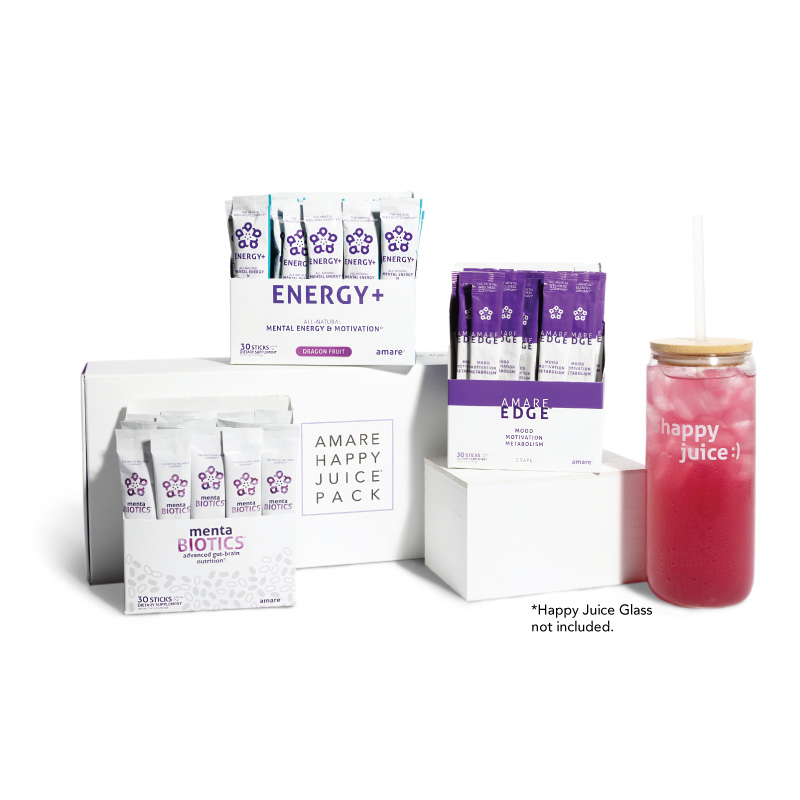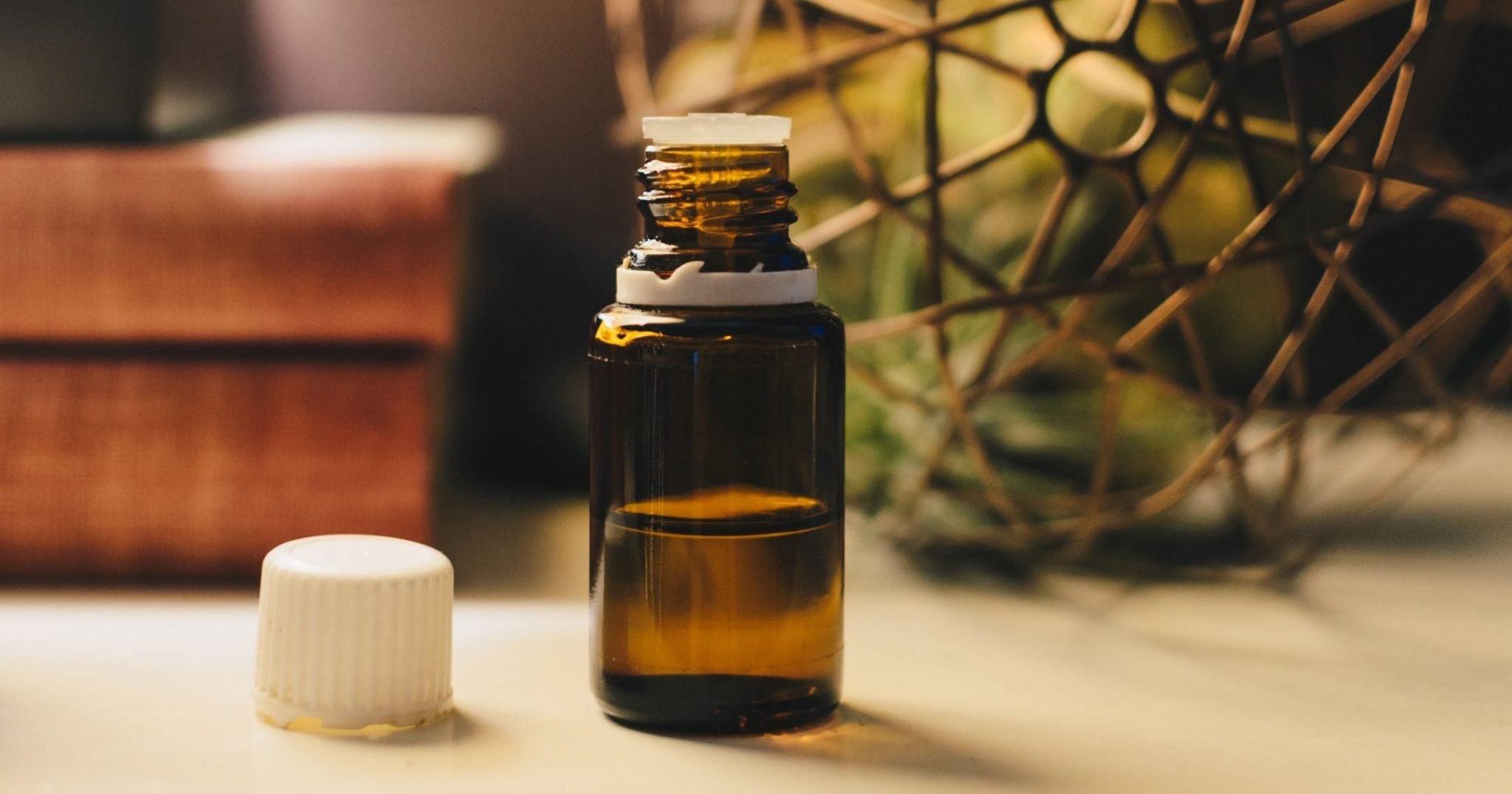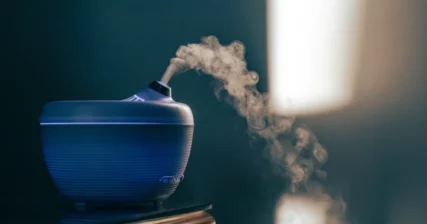Listen on: Apple Podcasts | Spotify
Do lavender and tea tree essential oils cause gynecomastia?…Of all the questions I get about essential oils, this question is in the top five.
As a (grand)parent, I understand the fear of doing something to hurt your child. That’s why sensationalized headlines, like “More evidence essential oils ‘make male breasts develop’,” get so much attention. Unfortunately, few people read the whole article, and instead read just the headline, and pass it along to friends.

Feel Better Fast. Guaranteed.
Energy+, EDGE, and MentaBiotics make up the Happy Juice supplement stack, with ingredients clinically proven to:
- decrease anxiousness scores by 55%
- decrease irritability scores by 60%
- decrease fatigue by 64%
- decrease anger 54%
- decrease tension by 45%
- decrease confusion by 43%
- decrease overall distress by 49%
- increase good bacteria by 70%
- decrease negative mood by 105%
- increase positive mood by 211%
After a couple of decades in health and fitness, I’ve observed very consistent patterns.
Possible side effects of natural products consistently get blown out of proportion, and their health benefits are often ignored. On the other hand, the health benefits of pharmaceuticals get hyped up while the side effects are often overlooked.
This is not an anti-pharma article. In fact, I believe there’s a lot of good reasons to rely on conventional medicine. There’s also plenty of value in alternative or natural health products. Unfortunately, most people believe you have to be on one side or the other. Not me…
To be 100% transparent, my wife and I are independent distributors for Young Living. If you don’t know me, you might assume that discredits what I’m going to write below. Those who do know me, know that I’ve built a career around helping people achieve optimal health with nutrition, exercise, supplementation, lifestyle choices, and yes, even essential oils.
My goal isn’t to convince you that essential oils are safe. It’s to encourage you to think for yourself, and come to your own conclusion. I’ll share some stuff to think about, and of course, weigh in with my own opinions. As a health-minded consumer, your health is 100% your responsibility. Be smart about who you listen to, and avoid getting caught up in sensationalized headlines.
What is Gynecomastia?
Gynecomastia is the development of breast tissue in males. As you know…boys have pecs, and girls have breasts.
At least that’s the case when things are normal. Sometimes, our metabolisms become dysfunctional, and men grow boobs, too.
Adult men can develop moobs (“man boobs”) when they have low testosterone. They can also develop gyno when their testosterone gets excessively high, or when they have a relatively quick increase in testosterone levels.
A significant rise in testosterone causes some to aromatize, or convert testosterone to estrogen.
Elevated estrogen stimulates the growth of breast tissue in men. A drop in testosterone, which decreases his ratio of testosterone to estrogen, can also cause gynecomastia.
Adolescent boys going through puberty experience similar surges in testosterone as those who take exogenous testosterone.
In fact, about 60% of boys experience gynecomastia for short periods during puberty. That’s normal. For about 10%, it persists.
Obesity, diet, and certain medications can increase estrogen levels and cause breast development as well. Obesity-related breast growth is called pseudogynecomastia. It is an enlargement of breast tissue due to excessive body fat gain, although fat cells are obesogenic and can further accelerate the growth of breasts in obese men.
Endocrine disruptors can cause gynecomastia as well. They are compounds that, as the name suggests, disrupt endocrine function. They influence the balance of sex hormones, thyroid, and other hormones.
Many endocrine disruptors are synthetic compounds found in food packaging, plastics, and personal care products.
Gynecomastia vs Prepubescent Gynecomastia
From toddler to teen, hormone levels say pretty steady. Gynecomastia is less common among preadolescents, but it isn’t rare.
The four main contributors are genetics, disease, diet, and endocrine disruptors.
The rise of childhood obesity is a likely contributor to gyno in young boys as well.
You might not know it, but some foods are higher in estrogens, including dried fruit, peas, beans, soybean, chickpeas, and tofu. Eating them in excess could contribute to elevated estrogen. We’re also exposed to hundreds of chemicals that can influence our hormones and the function of our cells. Many of those chemicals are found in personal care products.
And this brings us to essential oils and gynecomastia.
Essential Oils and Prepubescent Gynecomastia
A 2007 paper published in the New England Journal of Medicine first called out a connection between lavender and tea tree essential oils, and prepubescent gynecomastia.
The paper discussed the cases of three boys between the ages of four and ten who’d developed gynecomastia.
According to the paper, all three used personal care products that included lavender essential oil, or lavender and tea tree. No mention of their diet or other environmental factors is mentioned.
Nor is there mention of the specific types of commercial personal care products and what other ingredients they contained.
As the Endocrine Society has announced, multiple synthetic ingredients found in personal care products can act as endocrine disruptors.
Is it possible that the personal care products included some of those ingredients, and the essential oils were guilty by association? We don’t know.
Based on a case study size of three boys, the association is interesting, but far from showing causation.
The findings from the paper uncovered some possibilities. It’s possible:
- The young boys have a genetic anomaly that allowed the essential oils to really cause the gyno
- The personal care products the boys used shared a common endocrine disrupter and the essential oils were guilty by association
- The essential oils used in the products were perfume-quality essential oils and did have an estrogen-mimicking effect because they were not distilled properly, and lacked constituents that offset the estrogen-like effect
- The boys were exposed to endocrine disruptors in their home or environment that contributed to the breast development
- The boy’s diets contained estrogens
Remember, this paper, which has caused many people to suggest essential oils cause gynecomastia, is a paper that shows an association in three young boys. THREE.
A Follow-Up Study 10 Years Later
At the Endocrine Society’s annual meeting in March, 2018, J. Tyler Ramsey presented new findings that suggested lavender, tea tree, and other essential oils could contribute to gynecomastia.
Rather than using case studies like the paper from a decade ago, Ramsey and colleagues conducted an in vitro study using cancer cells.
Click to read full Endocrine Society press release: Chemicals in lavender and tea tree oil appear to be hormone disruptors
Chicago, IL – A new study lends further evidence to a suspected link between abnormal breast growth in young boys—called prepubertal gynecomastia—and regular exposure to lavender or tea tree oil, by finding that key chemicals in these common plant-derived oils act as endocrine-disrupting chemicals. The study results will be presented Monday at ENDO 2018, the Endocrine Society’s 100th annual meeting in Chicago.
Lavender and tea tree oil are among the so-called essential oils that have become popular in the United States as alternatives for medical treatment, personal hygiene and cleaning products, and aromatherapy. Various consumer products contain lavender and tea tree oil, including some soaps, lotions, shampoos, hair-styling products, cologne and laundry detergents.
“Our society deems essential oils as safe,” said study lead investigator J. Tyler Ramsey, a postbaccalaureate research fellow at the National Institute of Environmental Health Sciences (NIEHS), part of the National Institutes of Health. “However, they possess a diverse amount of chemicals and should be used with caution because some of these chemicals are potential endocrine disruptors.”
An endocrine-disrupting chemical is a chemical in the environment that interferes with hormones and their actions in the body.
Male gynecomastia occurring before puberty is relatively rare, but a growing amount of cases have been reported to coincide with topical exposure to lavender and tea tree oil, and the condition went away after the boys stopped using the oil-containing products, Ramsey said. Researchers at the NIEHS, including Kenneth Korach, Ph.D., a co-investigator for the new study, previously found laboratory evidence that lavender and tea tree oil have estrogenic (estrogen-like) properties and anti-androgenic (testosterone inhibiting-like) activities, meaning they compete or hinder the hormones that control male characteristics, which could affect puberty and growth.
Under Korach’s direction, Ramsey and his NIEHS colleagues went a step further. From the hundreds of chemicals that comprise lavender and tea tree oil, they selected for analysis eight components that are common and mandated for inclusion in the oils. Four of the tested chemicals appear in both oils: eucalyptol, 4-terpineol, dipentene/limonene and alpha-terpineol. The others were in either oil: linalyl acetate, linalool, alpha-terpinene and gamma-terpinene. Using in vitro, or test tube, experiments, the researchers applied these chemicals to human cancer cells to measure changes of estrogen receptor- and androgen receptor-target genes and transcriptional activity.
All eight chemicals demonstrated varying estrogenic and/or anti-androgenic properties, with some showing high or little to no activity, the investigators reported. Ramsey said these changes were consistent with endogenous, or bodily, hormonal conditions that stimulate gynecomastia in prepubescent boys.
“Lavender oil and tea tree oil pose potential environmental health concerns and should be investigated further,” he said.
Of further concern, according to Ramsey, is that many of the chemicals they tested appear in at least 65 other essential oils. Essential oils are available without a prescription and are not regulated by the U.S. Food and Drug Administration. Thus, the public should be aware of these findings and consider all evidence before deciding to use essential oils. The NIEHS Division of Intramural Research funded this study through its support of Korach.
Acquired March 2018 from: https://www.endocrine.org/news-room/2018/chemicals-in-lavender-and-tea-tree-oil-appear-to-be-hormone-disruptors
In an in vitro study, human cells are exposed to different chemicals, nutrients, or environments, and then observed to see how they respond. You probably did a test like this in your high school science class.
An in vitro study testing the estrogenic effects of essential oils on cells in a test tube is a long way from the type of study used to show cause and effect in the human body.
Unfortunately, news channels and online media pages prefer to jump to conclusions if it makes for more attention-grabbing headlines.
For example, a BBC web page covering the article had the headline “More evidence essential oils ‘make male breasts develop’.”
Holy crap! That sounds alarming! As alarming as the headline was, the final paragraph, quoting a statement from a pediatric oncologist, was equally amusing (and contradictory):
At present, there is insufficient evidence to support the concept that exposure to lavender and tea tree oil containing products cause gynaecomastia in children, and further epidemiological and experimental studies are required.
Dr. Rod Mitchell
Unfortunately, most people don’t read through to the end of the article like that. They just read the headline, and in their shock and fear, pass it along to their Facebook friends.
More Questions, No Answers
The key to learning is to ask better questions.
Before I form an opinion about a press release or published study, I ask questions. Then I do some of my own investigation.
For example, look at this statement:
“Male gynecomastia occurring before puberty is relatively rare, but a growing amount of cases have been reported to coincide with topical exposure to lavender and tea tree oil, and the condition went away after the boys stopped using the oil-containing products.”
I read it and asked:
How many cases is “a growing amount of cases?”
I tried to find prevalence data from the National Institute of Health (NIH). I already explained that gyno is very common among adolescents, and less common, but not rare, among preadolescent boys.
What I wanted to find out was the prevalence of gynecomastia related to essential oil use. I didn’t find anything through the NIH, so I went to PubMed, which is where I look for most of my research.
The most recent paper I found was a 2016 paper from the Journal of Pediatric Endocrinology and Metabolism: Prepubertal gynecomastia and chronic lavender exposure: report of three cases.
In this paper, three boys who developed gynecomastia, and were said to have been “chronically exposed to lavender.” As the paper explained, two of the three boys were exposed to a cologne that had lavender as an ingredient. So it wasn’t really lavender itself, but the cologne that might have had other compounds in it.
I also found another case study paper of a boy in a Spanish paper, titled Unilateral gynecomastia in young male due to tea tree oil.
The only other paper I could find was the one I cited in How to Use Critical Thinking with Essential Oils Cynics and mentioned above. It is the one paper everyone seems to point to, titled Prepubertal gynecomastia linked to lavender and tea tree oils, and published in the New England Journal of Medicine.
In this paper, the authors discussed the cases of three young boys who saw their doctors because of gynecomastia.
The mother of the first boy said she’d used a “healing balm” on his skin prior to the enlargement of the breast tissue. No further explanation of the healing balm’s ingredients is mentioned, other than the fact it contained lavender.
The second boy used a styling gel and a shampoo that contained lavender. Again, no mention of the other ingredients is made.
And for the third boy, he used a lavender-scented soap and occasionally used a lavender-scented commercial skin lotion. Interestingly, his fraternal twin did not display the same symptoms.
Unless I’m missing some papers, we’re talking about seven young boys. I suppose if the number went from seven to ten, you could call it a “growing number,” but even if we are talking about ten times as many boys, the number is still tiny compared to the number who use essential oils without issue. It’s also tiny compared to the number that develop gynecomastia.
Another statement I highlighted was this:
“(Researchers) previously found laboratory evidence that lavender and tea tree oil have estrogenic (estrogen-like) properties and anti-androgenic (testosterone inhibiting-like) activities, meaning they compete or hinder the hormones that control male characteristics, which could affect puberty and growth.
To which, I asked the question:
What “evidence” shows essential oils “compete or hinder the hormones that control male characteristics?”
Show me convincing evidence and I’ll wave the warning flag.
I believe low testosterone and excessive estrogen in men is a huge problem. If you could convince me essential oils are a problem, especially in comparison to chemicals in our diet and environment, or the estrogens in many of the foods that health “experts” recommend we eat, I’d steer men and boys clear of them in a heartbeat.
Selfishly, I want to protect my testosterone, too, which hovers between 1100-1350 ng/dL. Oh, and I do use plenty of essential oils, including lavender and tea tree.
The general tone of the press release was one of irritation at the world of essential oils, even starting off the press release with the statement, “Lavender and tea tree oil are among the so-called essential oils that have become popular in the United States…”
The inclusion of “so-called” in the sentence was no accident.
I must say that I’m also disappointed by the fact that all the headlines suggested lavender and tea tree were the problem, yet in the actual research, they only used individual constituents of the essential oils, including eucalyptol, 4-terpineol, dipentene/limonene and alpha-terpineol, linalyl acetate, linalool, alpha-terpinene and gamma-terpinene.
Which should cause one to ask:
Does the effect of an individual constituent act the same as when that constituent is part of the whole essential oil?
For someone with no science background, they might not know the answer. For a researcher at the caliber of the NIH, J. Tyler Ramsey most definitely should.
In fact, this is why some medications, which are individual chemicals found in plants can have such a powerful effect when isolated, and why they have side effects.
Here’s an easy way to understand the flaw in the study design, if they’re actually looking for the effects of essential oils.
Glutamic acid is a non-essential oil found in milk. If I wanted to show how milk causes neurological problems, headaches, or why it cannot improve muscle growth, I’d isolate glutamic acid and give high doses to people for a while as a main source of their protein.
They’d experience a number of side effects and would not get the benefits dairy protein is known for because I isolated one of the 18 amino acids. They’d end up malnourished and get toxic doses of glutamic acid. However, within the mix of amino acids found in milk, the glutamic acid is just fine for most people.
What Ramsey did is suggest essential oils have a certain physiological effect based on isolating an individual constituent out of the hundreds found in a therapeutic oil.
It’s not that his method is wrong. He was looking for something in oils that could have estrogenic effects. It’s that he then allowed the media to take the individual constituents, tested in isolation, and suggest that the whole essential oil acts the same way.
I have one more major question to throw out there. It is in regards to this statement from the release:
Using in vitro, or test tube, experiments, the researchers applied these chemicals to human cancer cells to measure changes of estrogen receptor- and androgen receptor-target genes and transcriptional activity.
I had to ask:
Are the researchers suggesting the results of a test tube study can be inferred to “cause and effect” in a human body?
As a health-minded consumer and fitness advocate, I want to make sure we consider all research through the same lens.
A test tube, or in vitro, study uses live cells, obviously removed from a human body, or grown in a lab. Then, those cells are exposed to different treatment environments.
Most scientists realize that an in vitro study is just a small step toward justifying a larger, more expensive, more time-consuming human study. The reality is, most in vitro research doesn’t pan out as expected when those same treatments are applied in a human being.
I don’t tell people that lavender can resolve a candida infection, even though an in vitro study shows that it does. That would be irresponsible of me.
Nor do I tell people that lavender essential oil can kill prostate cancer cells, even though in vitro studies have suggested this as well.
You can’t assume in vitro studies will hold up when completed in vivo…in the body.
On the flip side, if a researcher chooses to exaggerate the findings of an in vitro study to discredit natural products, he ought to be open to exaggerating the positive findings of other in vitro studies as well.
Does this change things for me?
In the end, the study created more questions than answers. Theoretically, that’s what an in vitro study should do. It’s a very long way from conclusions or “cause and effect.”
The last question I’m left with after reviewing all the information available to me is this: Does this change things for me?
Does it cause me to doubt what I believe? If so, I’m open to changing my beliefs. As a maturing man, I’ve come to appreciate the fact that personal growth is about rethinking beliefs. Especially those beliefs that I cling to with the most emotion.
However, there’s nothing in this new finding about essential oils, or in the papers I read to prepare this article, that changes what I believe.
IF one day it’s shown that therapeutic-quality lavender and tea tree could cause gynecomastia in a very small percentage of males, it still wouldn’t change how I’d recommend it because the gyno is reversible. To me, it’s like whey protein. Whey has some super-impressive health benefits, but some people don’t tolerate it. I’m one of them. So, I recommend it for those who do tolerate it, and for those of us who don’t, we just have to find an alternative.
I’ll probably put a little lavender in the diffuser or on my feet tonight and peacefully fall asleep.
By the way, you might also like to read Essential Oils For Fitness: Research, Anecdotal Evidence, Experimentation.

Feel Better Fast. Guaranteed.
Energy+, EDGE, and MentaBiotics make up the Happy Juice supplement stack, with ingredients clinically proven to:
- decrease anxiousness scores by 55%
- decrease irritability scores by 60%
- decrease fatigue by 64%
- decrease anger 54%
- decrease tension by 45%
- decrease confusion by 43%
- decrease overall distress by 49%
- increase good bacteria by 70%
- decrease negative mood by 105%
- increase positive mood by 211%



